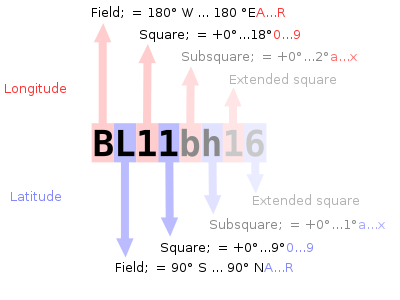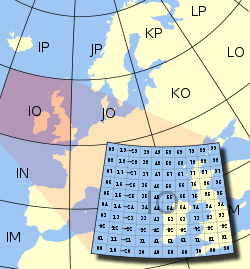Oe1mcu (Diskussion | Beiträge) |
Oe3gsu (Diskussion | Beiträge) |
||
| Zeile 5: | Zeile 5: | ||
Maidenhead Locator werden werden landläufig als ''grid locators = Gitter Position'' oder ''grid squares = Gitterfelder'' bezeichnet, trotzdem das sie einer nicht rechteckige Form und keiner Rektangularprojektion entsprechen. | Maidenhead Locator werden werden landläufig als ''grid locators = Gitter Position'' oder ''grid squares = Gitterfelder'' bezeichnet, trotzdem das sie einer nicht rechteckige Form und keiner Rektangularprojektion entsprechen. | ||
| − | == | + | ==Beschreibung des Systems== |
Der Maidenhead Locator komprimiert die Länge und Breite in eine kurze Abfolge von Zeichen. Die Positionsinformation wird beim Maidenhead Locator in eine geringere Genauigkeit umgewandelt um die zu übertragende Anzahl der Zeichen für Sprache, Morse und digitale Funkübertagung gering zu halten. | Der Maidenhead Locator komprimiert die Länge und Breite in eine kurze Abfolge von Zeichen. Die Positionsinformation wird beim Maidenhead Locator in eine geringere Genauigkeit umgewandelt um die zu übertragende Anzahl der Zeichen für Sprache, Morse und digitale Funkübertagung gering zu halten. | ||
Version vom 17. September 2009, 19:39 Uhr
Das Maidenhead Locator System ist ein geographisches Koordinaten System welches von Funkamateuren verwendet wird. Dr. John Morris, G4ANB, der urprüngliche Erfnder, und eine Gruppe an VHF Managers riefen bei einem Treffen in Maidenhead (England 1980) das Maidenhead System ins Leben. Das Maidenhead Locator System ersetzte das alte QRA Locator System. Das Maidenhead System wird heute weltweit genutzt. Das Maidenhead (QTH-Locator) System ermöglicht die schnelle Übermittlung der Positionen zwischen Funkamateuren in einer Funkverbindung.
Maidenhead Locator werden werden landläufig als grid locators = Gitter Position oder grid squares = Gitterfelder bezeichnet, trotzdem das sie einer nicht rechteckige Form und keiner Rektangularprojektion entsprechen.
Beschreibung des Systems
Der Maidenhead Locator komprimiert die Länge und Breite in eine kurze Abfolge von Zeichen. Die Positionsinformation wird beim Maidenhead Locator in eine geringere Genauigkeit umgewandelt um die zu übertragende Anzahl der Zeichen für Sprache, Morse und digitale Funkübertagung gering zu halten.
Das gewählte Kodierungsverfahren nutzt abwechselnde Paare von Zeichen und Ziffern die folgendermaßen aussehen:
- JN67bh16
In jedem Paar codiert das erste Zeichen die Länge und das zweite Zeichen die Breite. These character pairs have also traditional names, and in the case of letters, the range of characters (or "encoding base number") used in each pair does vary.
In order to avoid negative numbers in the input data, the system also specifies that latitude is measured from the South Pole to the North Pole, and longitude measured eastward from the antimeridian of Greenwich, giving the Prime Meridian a false easting of 180° and the equator a false northing of 90°.
To simplify manual encoding, the base for the first pair of letters—traditionally called a field—was chosen to be 18, thus dividing the globe into 18 zones of latitude of 10° each, and 18 zones of longitude 20° each. These zones are encoded with the letters "A" through "R".
The first pair of numbers, called a square and placed after the first pair of letters, uses a base number of 10, and is encoded using the digits "0" to "9". This is where the alternative name "grid squares" comes from. Each of these squares represents 1° of latitude by 2° of longitude.
For additional precision, each square can optionally be sub-divided further, into subsquares. These are encoded into a second pair of letters, often (but not always) presented in lowercase, and again, to make manual calculations from degrees and minutes easier, 24 was chosen as the base number, giving these subsquares dimensions of 2.5' of latitude by 5' of longitude. The letters used are "A" through "X".
The resulting Maidenhead subsquare locator string is hence composed of two letters, two digits, and two more letters. To give an example, W1AW, the American Radio Relay League's Hiram Percy Maxim Memorial Station in Newington, Connecticut, is found in grid locator Vorlage:Coor Maidenhead. Two points within the same Maidenhead subsquare are always less than 12 km apart, which means a Maidenhead locator can give significant precision from just six easily transmissible characters.
For even more precise location mapping, two additional digits were proposed and ratified as an extended locator, making it altogether eight characters long, and dividing subsquares into even smaller ones. Such precision has uses in very short communication spans. Beyond this, no common definition exists to extend the system further into even smaller squares. Most often the extending is done by repeating alternating subsquare and square rules (base numbers 24 and 10 respectively). However, other bases for letter encodings have also been observed, and therefore such extended extended locators might not be compatible.
The Maidenhead locator system has been explicitly based on the WGS 84 geodetic datum since 1999. Before that time, it was usually based on each user's local national datum, which do differ slightly from one another and WGS 84. As a result, stations very near the edges of squares at denoted precision may have changed their locators when changing over to the use of WGS 84.
To summarize:
- Character pairs encode longitude first, and then latitude.
- The first pair (a field) encodes with base 18 and the letters "A" to "R".
- The second pair (square) encodes with base 10 and the digits "0" to "9".
- The third pair (subsquare) encodes with base 24 and the letters "A" to "X".
- The fourth pair (extended square) encodes with base 10 and the digits "0" to "9".
- The fifth and subsequent pairs are not formally defined, but recycling the third and fourth pair algorithms is one possible definition:
- BL11bh16oo66
On shortwave frequencies, positions are reported at square precision, and on VHF and UHF, subsquare precision is used. More precise position reports are very rarely used.
Use by radio amateurs
Today, individual radio amateurs and organizations around the world recognize and use Maidenhead locators. Many utilities exist to convert latitude and longitude to locators, as this is a favorite hack for programmers who are also radio amateurs. Commercially available (civil) Global Positioning System receivers are frequently able to display Maidenhead locators.
Maidenhead locators are used as part of the formulas for scoring in many VHF amateur radio contests. Grid locators are also the basis of earning many awards like the; American Radio Relay League's VHF/UHF Century Club, URE TTLOC, etc. operating award.
In IARU Region 1 rules, VHF distances are calculated from maidenhead subsquare centers using a spherical Earth. This results in a small error in distance, but makes calculations quite simpler, and given the inherent imprecision in the used input data, it is not the biggest error source.
External links
- ARRLWeb: Grid Locators and Grid Squares
- ARRLWeb: Calculate Grid Square
- On-line locator database with over 135,000 callsigns
- From the field hunter's web page: An explanation of the system and how it came into being.
- Maidenhead Grid Squares
- Find grid square and lat/long for any address or ham call sign, plotted on Google Maps
- Find your QTH locator with GoogleMaps
- Find QTH locator or grid square with GoogleMaps and approximate distance between two squares
- Generate a KML file from a Maidenhead coordinate
- Perl module for converting between geographic coordinates and Maidenhead locator and calculating distance and bearing
- Hamlib, a portable library for converting between geographic coordinates and Maidenhead locator and calculating distance and bearing
- C# class for converting between geographic coordinates and Maidenhead locator and calculating distance and bearing
- A small Java application to display the current Grid Locator for phones with GPS capability such as the Nokia N95
QUELLE: en.wikipedia.org


Diskussionen